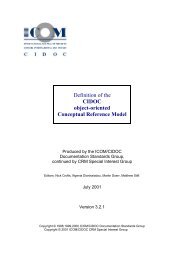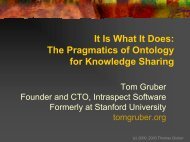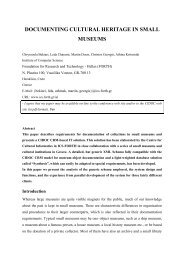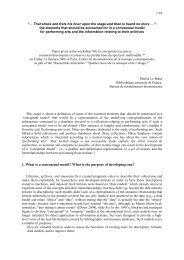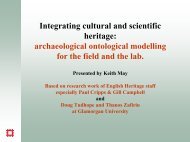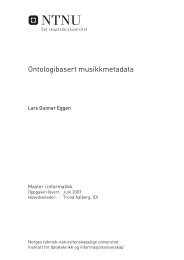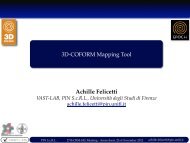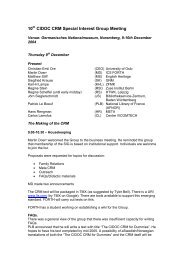pdf file - The CIDOC CRM
pdf file - The CIDOC CRM
pdf file - The CIDOC CRM
You also want an ePaper? Increase the reach of your titles
YUMPU automatically turns print PDFs into web optimized ePapers that Google loves.
to other concepts by logical terms.<br />
extension<br />
scope note<br />
instance<br />
<strong>The</strong> extension of a class is the set of all real life instances belonging to the class that fulfil<br />
the criteria of its intension. This set is “open” in the sense that it is generally beyond our<br />
capabilities to know all instances of a class in the world and indeed that the future may<br />
bring new instances about at any time (Open World). An information system may at any<br />
point in time refer to some instances of a class, which form a subset of its extension.<br />
A scope note is a textual description of the intension of a class or property.<br />
Scope notes are not formal modelling constructs, but are provided to help explain the<br />
intended meaning and application of the <strong>CRM</strong>’s classes and properties. Basically, they<br />
refer to a conceptualisation common to domain experts and disambiguate between different<br />
possible interpretations. Illustrative example instances of classes and properties are also<br />
regularly provided in the scope notes for explanatory purposes.<br />
An instance of a class is a real world item that fulfils the criteria of the intension of the<br />
class. Note, that the number of instances declared for a class in an information system is<br />
typically less than the total in the real world. For example, you are an instance of Person,<br />
but you are not mentioned in all information systems describing Persons.<br />
For example:<br />
<strong>The</strong> painting known as the “<strong>The</strong> Mona Lisa” is an instance of the class Man Made Object.<br />
An instance of a property is a factual relation between an instance of the domain and an<br />
instance of the range of the property that matches the criteria of the intension of the<br />
property.<br />
For example:<br />
“<strong>The</strong> Louvre is current owner of <strong>The</strong> Mona Lisa” is an instance of the property “is current<br />
owner of”.<br />
property<br />
A property serves to define a relationship of a specific kind between two classes. <strong>The</strong><br />
property is characterized by an intension, which is conveyed by a scope note. A property<br />
plays a role analogous to a grammatical verb, in that it must be defined with reference to<br />
both its domain and range, which are analogous to the subject and object in grammar<br />
(unlike classes, which can be defined independently). It is arbitrary, which class is selected<br />
as the domain, just as the choice between active and passive voice in grammar is arbitrary.<br />
In other words, a property can be interpreted in both directions, with two distinct, but<br />
related interpretations. Properties may themselves have properties that relate to other<br />
classes (This feature is used in this model only in order to describe dynamic subtyping of<br />
properties). Properties can also be specialized in the same manner as classes, resulting in<br />
IsA relationships between subproperties and their superproperties.<br />
In some contexts, the terms attribute, reference, link, role or slot are used synonymously<br />
with property.<br />
For example:<br />
“Physical Man-Made Thing depicts <strong>CRM</strong> Entity” is equivalent to “<strong>CRM</strong> Entity is depicted<br />
by Physical Man-Made Thing”.<br />
subproperty<br />
A subproperty is a property that is a specialization of another property (its<br />
superproperty). Specialization or IsA relationship means that:<br />
1. all instances of the subproperty are also instances of its superproperty,<br />
2. the intension of the subproperty extends the intension of the superproperty, i.e. its<br />
traits are more restrictive than that of its superproperty,<br />
3. the domain of the subproperty is the same as the domain of its superproperty or a<br />
subclass of that domain,<br />
4. the range of the subproperty is the same as the range of its superproperty or a<br />
subclass of that range,<br />
5. the subproperty inherits the definition of all of the properties declared for its<br />
superproperty without exceptions (strict inheritance), in addition to having none,<br />
one or more properties of its own.<br />
Definition of the <strong>CIDOC</strong> Conceptual Reference Model<br />
x



